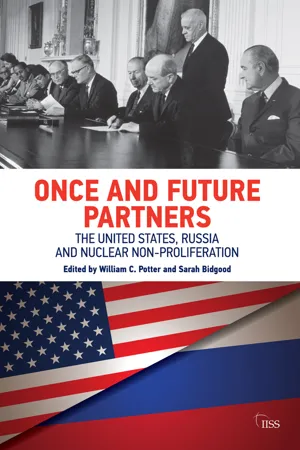United States
The change in US policy from secrecy/denial to active promotion of peaceful applications of atomic energy was clearly signalled in President Dwight Eisenhower’s famous ‘Atoms for Peace’ speech before the UN in December 1953. Eisenhower acknowledged in his address that the secret of the atom eventually would be acquired by other states, and he emphasised the need to exploit those properties in the atom that were good rather than evil. More specifically, he proposed that the governments principally involved in nuclear R&D make joint contributions from their stockpiles of fissionable materials to an International Atomic Energy Agency (IAEA). The agency was to be set up under the jurisdiction of the UN and would be responsible for the storage and protection of contributed fissionable materials. The IAEA also was to have the important responsibility for devising methods to distribute fissionable material for peaceful purposes, especially electrical energy production.
It took nearly four years before Eisenhower’s Atoms for Peace proposals found fruition in the establishment of the IAEA. Not only did opposition to the proposals from the Soviet Union need to be overcome, but substantial revisions had to be made in the very restrictive 1946 US Atomic Energy Act. These changes were incorporated in the Atomic Energy Act of 1954 and included the removal of most controls on the classification of information regarding nuclear research, approval of private ownership of nuclear facilities and fissionable material by private industry, and authorisation of the government to enter into agreements for cooperation with other nations on the peaceful uses of nuclear energy. Although these agreements required guarantees by the recipient of nuclear materials or equipment to forswear their use for military purposes, the 1954 Act clearly signalled a basic reordering of US nuclear non-proliferation and export-control priorities. As one observer of the change in US policy pointed out: ‘While the idea of safeguards and protective requirements was by no means forsaken, it now took a backseat to the promotion of atomic energy domestically and internationally.’9
One of the ironies of the period of relaxed control over nuclear information ushered in by Eisenhower’s Atoms for Peace programme was the development of a US–Soviet peaceful nuclear-energy and -prestige race in tandem with the superpower arms race. One aspect of the former competition was the rush by both the Soviet Union and the US to declassify and disseminate a large volume of technical nuclear information. By 1958, this competition had resulted in the adoption of new guidelines for information declassification in the US that made it possible for any nation to gain access to almost all basic scientific information on research, development and the operation of plants and equipment in the field of nuclear fission.10
During the same period in the 1950s, the US moved to the fore-front in the international nuclear-export race, exploiting its lead in the field of enriched-uranium research reactors to capture the market abroad. The US position as the only supplier of enriched uranium for these reactors gave it an invaluable political as well as commercial advantage and enabled it ‘to require that the reactors be used only for peaceful purposes, and be inspected first by Americans and then by the IAEA’.11
The administrations of Eisenhower, Kennedy, Johnson and Nixon differed widely in their commitment to nuclear-test limitations and other negotiated non-proliferation restrictions. However, until 1974, both Democratic and Republican administrations were inclined to discount – or at least minimise – the relationship between the worldwide growth of nuclear power and the risk of nuclear-weapons proliferation. As such, they tended to subordinate the military implications of nuclear exports to those of commercial advantage. It is telling, for example, that even the major non-proliferation accomplishment of that period, the 1968 Treaty on the Non-Proliferation of Nuclear Weapons (Non-Proliferation Treaty, or NPT), was promoted by both superpowers as a grand nuclear bargain in which the nuclear powers would provide non-nuclear-weapons states with civilian nuclear technology for peaceful purposes in exchange for the latter’s pledge to forgo a military capability. This ambiguous division between peaceful and military nuclear activity was reinforced by language in the treaty that distinguished between peaceful and military nuclear-explosive capability. Benefits from the former, it was promised, would be made available to non-nuclear parties to the treaty at a low cost.
If the defining characteristic or tendency of the second phase in the evolution of Soviet and US non-proliferation policy was promotion of the peaceful use of the atom, another very important feature of this period was maintaining alliance relations. During the Eisenhower administration, this meant giving priority to the retention of flexibility in the employment of nuclear weapons over that of the ‘non-dissemination’ or ‘non-diffusion’ of nuclear weapons, as non-proliferation typically was referred to at the time. According to one former US government official, this meant, among other things, placing ‘a higher premium on nuclear weapons cooperation with [US] allies – even at the price of encouraging and stimulating independent atomic-weapons programs – than … seeking international agreements retarding the spread of nuclear weapons’.12 Pentagon officials, for example, made the case that the spread of nuclear weapons ‘would work to the advantage of the United States because the Soviet Union would not allow its unreliable Eastern European allies to acquire nuclear weapons’, while weapons spread to allies such as France and Japan ’would add to the Western advantage in nuclear weapons’.13
To be sure, US nuclear policy was not constant during the Atoms for Peace period, and the priority given to non-proliferation rose following the 1960 presidential election. Nevertheless, US nuclear pol...
